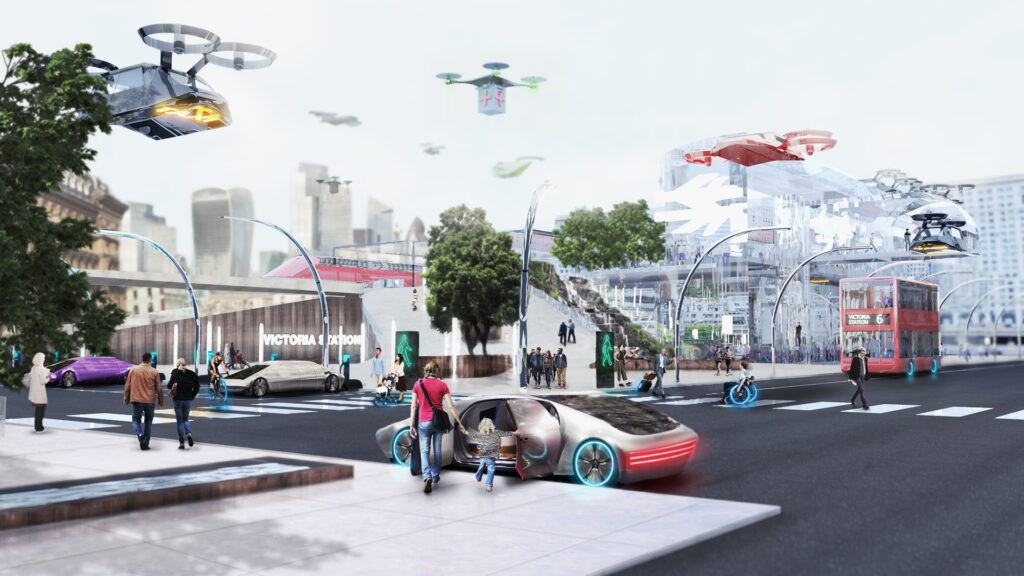
Through the Future of Mobility Grand Challenge government arm UKRI (UK Research & Innovation) is investing in technology and innovation that will help propel us towards net zero.
Comments below from UKRI Challenge Directors on the upcoming announcement and previous pledges – such as the Prime Minister’s pledge to power homes with wind energy by 2030; the next stage for electric vehicles as diesel vehicles become banned by 2030; and the need for clean aviation.
Artist’s image of how a 2050 net zero future could look in the UK. Drones carrying medical supplies; urban air vehicles; electric public transport; super-fast charging points for electric vehicles and – most importantly, cleaner air.
UKRI Challenge Director of Robotics, Andrew Tyrer comments on the PM’s wind power pledges:
“Wind power is the UK’s strongest source of renewable energy and the Prime Minister has shown his faith in it with pledges for all UK homes to be powered by wind energy by 2030. Wind energy currently makes up 20% of the UK’s electricity supply and is rapidly expanding. By 2030, the UK offshore windfarm market is set to reach a capacity of 40GW, so it is crucial for the future of the country’s green energy.
However, in order to reach net zero, we need to ensure wind farms are working to their full potential, otherwise we are literally wasting energy. Through its ‘Robots for a Safer World’ challenge, UK Research & Innovation (UKRI) is funding and supporting robotics companies which are working towards this goal – companies such as BladeBUG and Innvotek, which create robots to inspect and maintain wind turbines and keep them functioning at an optimum level.
Being remote and off-shore requires efficient installation and then ongoing inspection, maintenance and repair of these new infrastructures. Robotics can be utilised to automate many inspection and maintenance tasks driving decreased lifetime cost of the assets; decreased downtime, increased availability to generate electricity, and; not putting operatives in dangerous workplaces, so reducing Health and Safety incidents and increasing productivity.
Robots will be ‘housed’ on these offshore farms permanently and future generations of turbine may be designed to be repaired and maintained by robots throughout their lifecycle.”
Tony Harper, Challenge Director – Faraday Battery Challenge comments on the next stage for electric vehicles:
“The UK is globally competitive in next-generation battery technologies. Many UK battery SMEs are leading in their fields, outperforming international enterprises which receive large commercial investment. Through the Faraday Battery Challenge, delivered by UK Research & Innovation (UKRI), the UK has developed institutions which will accelerate the advancement of emerging and next-generation technologies, including the UK Battery Industrialisation Centre (UKBIC) which is the first facility of its kind in the world.
There is great opportunity for the UK automotive industry as it electrifies. It is predicted that 1.5million electric vehicle batteries will be produced per year in the UK by 2040. To support this, approximately seven UK battery manufacturing facilities, or ‘gigafactories’ are required. The Faraday Battery Challenge is working with other UK institutions, companies and potential investors to help accelerate Gigafactory plans in the UK.
The electrification of the automotive industry alone has the potential to generate 78,000 jobs in the UK and there are also significant opportunities as other sectors – including aerospace, rail and marine – look to electrify. All of this relies on the UK developing world-class technology and a robust, local battery value chain.”
Gary Cutts, Challenge Director – Future Flight responds to clean aviation needs:
“In moving towards a sustainable, net-zero carbon transport system we need to deal with the introduction of new energy sources but also to optimise and integrate the use of the total system to minimise waste. Whilst the innovation for the vehicles themselves is challenging we also a need significant capability acquisition and scale-up in the supporting infrastructure. Typically the vehicle segment has more attention and funding, it represents a more visible element of the transport system, but that the final enabler is the infrastructure the vehicles operate within. Infrastructure here can refer to physical assets but also the inter-connected digital systems which allow the new modes of transport to operate efficiently.
Whilst we are developing these longer range zero-carbon systems, we may seek the shorter term wins of reducing waste in the transport sector by approaches such as airspace modernisation, integrated transport hubs and operational optimisation. These all require investment.
There is a need to provide electricity distribution and charging systems for automotive products at scale by 2025 but also for initial aviation applications. There will naturally be an increase in the demand for clean electricity production to ensure that the system is truly zero carbon.
For aviation, hydrogen is a credible fuel source too and this would require a system of (clean) hydrogen generation, distribution storage and fuelling. The same systems requirements would apply to synthetic aviation fuels.
To provide a fully integrated, sustainable transport system we need proper physical and digital connections between different modes of transport allowing seamless, efficient journeys using a range of vehicles.
Many of the new modes of transport will also feature high degrees of autonomy requiring a cyber secure control system to be created which may represent a new critical national infrastructure capability.”














More Stories
Meet Rita Case – recipient of 2024 NAMAD Lifetime Achievement Award
Contechs appoints Christopher Hilts as US Head of Business Development
Cybord inline visual AI analytics identifies defective components on the fly